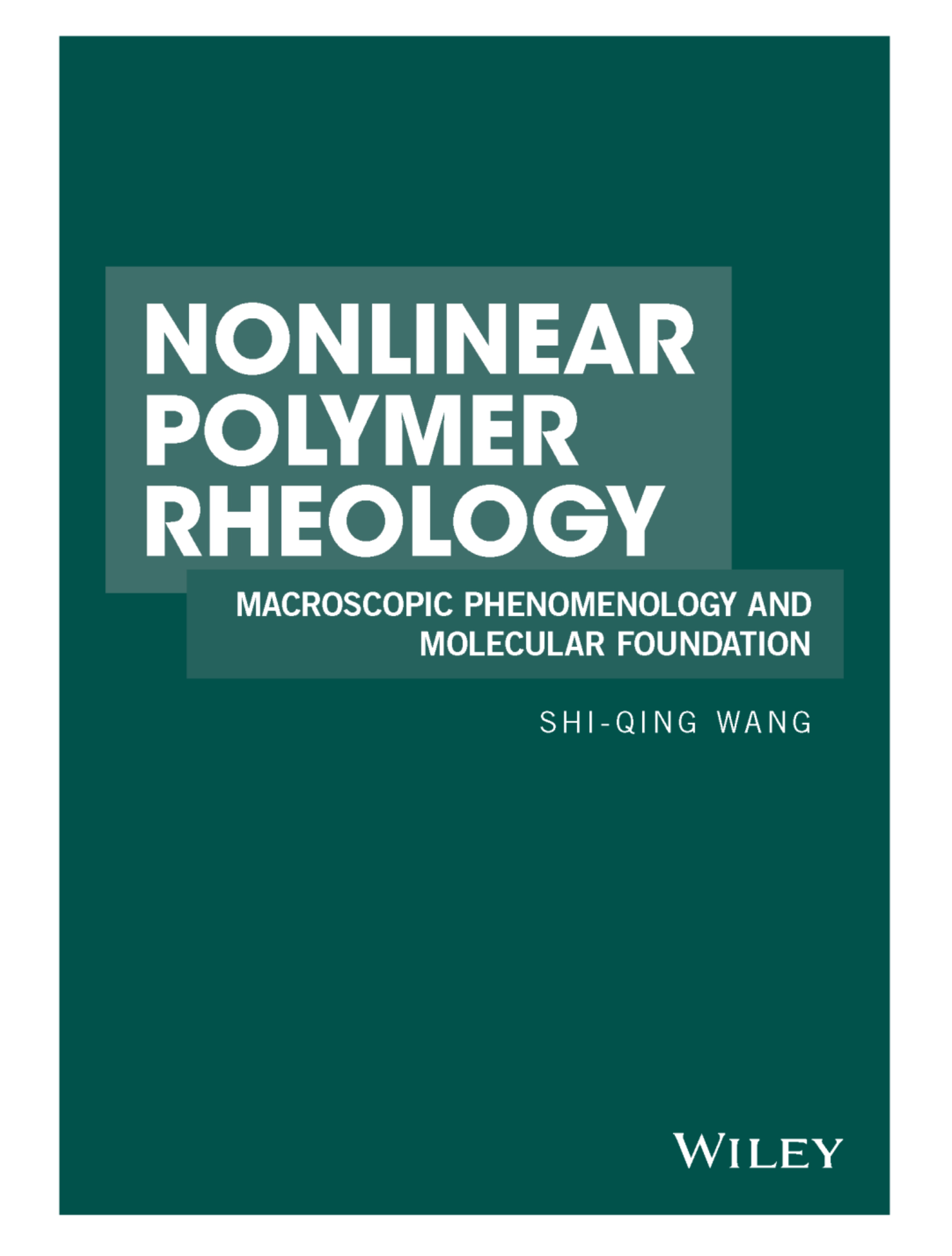
Shi-Qing Wang
Distinguished Professor and Kumho Professor
Ph.D. (Physics), University of Chicago (1987)
Fellow of the American Physical Society (1997)
Fellow of American Association for the Advancement of Science (2014)
Member of American Physical Society, Society of Rheology
 |
Available from Wiley & Wiley Online Library Available from Amazon
Free at last Let long chains join the elastic network, |
Curiosity is a fountain of happiness.
Since we are curious, every day is a holiday.
- SQ Wang
YouTube links for the recent lecture series (29 lectures) on Nonlinear Polymer Rheology: Introductory and Closing Remarks.
Polymer Physics channel has been created on YouTube, which hosts over 50 lectures on various aspects of polymer physics related to rheology and fracture mechanics.
Research Interests
Physics and engineering of polymers: exploration of relationships between processing, structure and mechanical properties of all polymeric materials including sustainable polymers. Phenomenological and conceptual foundations of polymer melt rheology and molecular mechanics of polymers in solid state, either plastic or elastomeric. Fracture mechanics of plastics and elastomers.
Current Activities
Our current research involves three episodes in the saga to develop a unified framework for mechanical characteristics of polymers in both liquid and solid states: rheology of polymeric liquids, molecular mechanics of glassy and semicrystalline polymers and fracture behavior of plastics and elastomers. Several hundred billion pounds of polymers are annually consumed thanks to their adequate mechanical characteristics. Thus, greater knowledge of mechanical performance of polymers is a core objective in polymer science and engineering. Our understanding of Nonlinear Polymer Rheology (Wiley, 2018) provides us valuable insights into when and how glassy and semicrystalline polymers gain ductility and resist fracture in solid state. Moreover, deep molecular-level understanding of mechanical behavior in liquid and glassy states has served us well in the exploration of fracture mechanics of polymers in plastic and elastic states. A second book Physics of Polymer Mechanics is in preparation for publication by Wiley in 2025-2026.
Episode 3: Fracture Mechanics of Plastics and Elastomers
Equipped with the understanding of the nature of brittle-ductile transition in glassy polymers (see Episode 2a below), we show that toughness of plastics may be controlled by inherent strength. Separately, ongoing research in our lab shows that time dependent fracture behavior of elastomers, e.g., a vulcanized rubber is more stretchable when stretched faster or stretched at a lower temperature, can be understood by identifying the hidden timescale, i.e., the network lifetime related to bond dissociation time. Considerable progress has been summarized in a recent Perspective in Macromolecules. A video recording on elastomeric fracture is in Youtube.
Episode 2b: Brittle vs. Ductile Characteristics of Semicrystalline Polymers
Semicrystalline polymers can be conveniently classified into two groups depending on whether their glass transition temperature is above or below room temperature. According to this classification, polymers such as polyethylene and polypropylene belongs to class A and polyesters such as PET and poly(lactic acid) belong to class B. It is often noted that class B semicrystalline polymers (SCPs) are brittle (at room temperature) in the presence of saturated crystallization while their counterparts, i.e., the same polymers in their amorphous glassy state can be ductile. Our current efforts are directed to develop a basic molecular-level understanding of mechanical behavior of semicrystalline polymers so that tough semicrystalline polymers can be manufactured without invoking any chemical changes. To establish a realistic model for mechanics of SCPs, it is indispensable for us to have a thorough understanding of the other two subjects listed below as 1. Nonlinear melt rheology and 2a. Molecular mechanics of glassy polymers. Subjects 1 and 2a allow us to develop processing-structure-property relationship for SCPs. See our back-to-back papers on this topic.
Episode 2a: Molecular Mechanics of Glassy Polymers
Recently we have come to realize how we should think about
It turns out that a crucial clue comes from the observation that all non-polymeric organic glasses are brittle. There arises the natural question of why polymeric glasses can be ductile at all? Being polymeric is the key. We have formulated a molecular model [ J. Chem. Phys. 141, 094905 (2014); Polymer 197, 122445 (2020)] for yielding, crazing and brittle-ductile transition. In the zeroth-order picture, polymer glasses are structural hybrids, made of a primary structure due to short-ranged inter-segmental attractions (causing vitrification) and long-ranged chain networking that can be extended to allow buildup of chain tension, plausibly corresponding to bond length and angle deviations from the equilibrium values. Polymer glass gains global plasticity and is ductile at a given temperature if its chain network can activate the glassy state globally. Conversely, if the chain network breaks down before it brings about activation, a polymer glass is going to undergo brittle fracture. Here the chain network is envisioned in terms of junctions formed by at least two pairs of hairpins from different chains.
Episode 1: Nonlinear Melt Rheology
Many of these polymers, such as polyethylene and polybutadiene, are well entangled liquids above melting and glass transition temperatures. The research in the past decade has informed us that well entangled polymers, as highly viscoelastic liquids, behave as transient solids and undergo cohesive breakdown upon either startup deformation or large step strain or large amplitude oscillatory, A new worldview has emerged [J. Chem. Phys. 127,064903 (2007)]. The localized yielding phenomenon leads to strain localization such as shear banding and non-quiescent relaxation. A new worldview has emerged, in which we have developed a unified treatment of deformation and flow in both shear and extension. See Nonlinear Polymer Rheology (Wiley, 2018).
